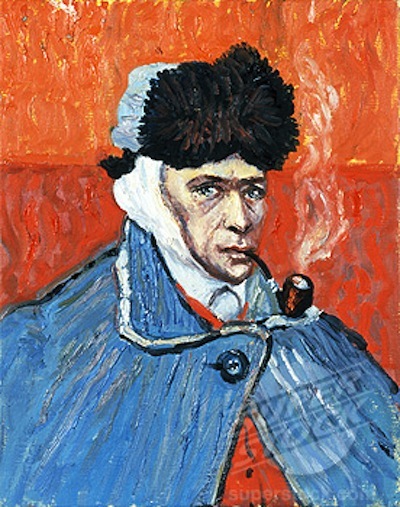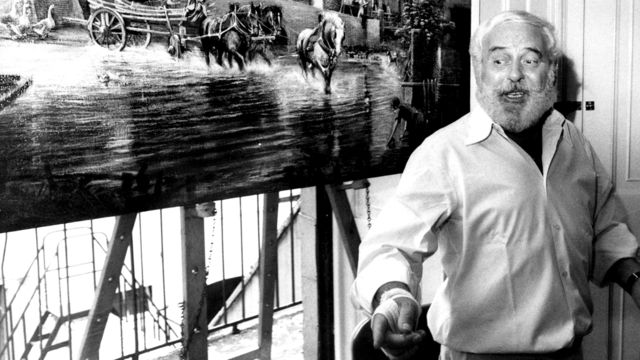
Forged
Why Fakes Are the Great Art of Our Age
Jonathon Keats
(Oxford)

Keats takes up the cudgels for forgers. And why not? If we come upon a painting or sculpture that touches us, makes us sizzle or go goosebumpy or weak in the knees, do we care if some guy did it up in the back of his garage in Altoona instead of an arid studio in Arles? And what is art, anyway?According to the writer, great art must produce "Questioning. Provoking. Agitating."
These are the most productive attributes of modern art. Compelling art does not merely depict anxiety, but induces it, awakening us to the invidious conditions of the dystrophia in which we live, so that the engine of progress does not make tools of us.
"Questioning. Provoking. Agitating?" A bad movie can produce these reactions. A car wreck. The death in the family. Here, Keats is drawing us in, creating the same threesome for forgers. But are we provoked when we learn a painting we love is a fake? Are we agitated if someone sells our local museum a Matisse, a Corot, or a Vermeer that was drawn, sketched or painted by Lothar Malskat, Alceo Dossena, Elmyr de Hory, Eric Hebborn, Han van Meegeren, Tom Keating? We may be questioning: how come the experts didn't catch this one before it got sold for so many hundreds of thousands?
The discovery of the existence of a fake puts everyone in a bind. Who is to question the obvious? And who are we to question the experts? Eric Hebborn created a drawing by Jan Brueghel the Elder. It was one of the thousand or so he forged before he died in 1996. It now hangs in the Metropolitan Museum of Art, titled The Temples of Venus and Diana on the Bay of Baia. It is attributed to Jan Brueghel the Younger. Thus a forger has become one of a family of artists who lived over three centuries ago. As Keats has it, "Expressed through his forgeries, Hebborn's philosophy upset the idea that history is strictly past tense."
§ § § At times, dealers and artists become complicit. Lothar Maskat worked in Europe before and after WWII. In the postwar period many valuable paintings which had been "looted from foreign museums or from Jewish collectors" were floating around. Asking questions about the provenance "was verboten." It was an easy time for forgers.
But since, several of the painters manqué have confessed to their workings. Hebborn wrote a book proclaiming that in his almost forty years of hard work, he had produced drawings attributed to Poussin, Piranesi, Rubens, Gainsborough and Corot. He even worked the 20th century, producing credible fakes of David Hockney and Augustus John. In his autobiography, Drawn to Trouble, he reveals that his copies of the latter's works are now worth more than the originals,
The collector is able to buy several genuine examples for the money they would now have to pay for a single "John" of my own making.
This increased value of the fakers' art seems to be the norm. Tom Keating's renditions of the paintings of Blakes Sexton now are worth far more than the original. The latest sale at Christie's in 1984, some two hundred fakes brought in almost £300,000 (more than a half a million dollars). God knows what they are worth now.
Tom Keating perceived the gallery system to be rotten. It was dominated, he said, by American "avant-garde fashion, with critics and dealers often conniving to line their own pockets at the expense both of naïve collectors and [of] impoverished artists." Keating retaliated by creating forgeries to fool the experts, hoping to destabilize the system.
§ § § The art market being as peculiar as it is, "Increasingly collectors and gallerists deferred connoisseurship to experts and judged paintings on the basis of certificates." For Elmyr de Hory, this became his area of expertise.
Intended to thwart forgery, the system made Elmyr's job easier: A certificate was far simpler to fake than a painting.
Certificates from the family were important, one from the artist himself was best. Cette peinture est de moi was attached to "Still Life with Jug," the note being a superb fake by all counts,
The scrawled note was persuasive partly because of the handwriting but primarily because the offhand quality was in keeping with Picasso's impulsive character.
"Like most convincing forgeries, it was the produce of impersonation."
Forgery is going on all about us, all the time, and most of it is pretty bad. Years and years ago, when I visited the Prado in Madrid, there was usually someone seated before an original Titian, Velasquez Rembrandt or de Vinci assiduously copying the art onto their own canvas. Most of these copyists were creating awful copies, but it gave a nice insight. Just by looking at a poorly organized copy, wretchedly done, one was able to hone in on the greatness of the original: the color, the balance, the strokes, the technique. The students just didn't have what it took.
Which makes us have more respect for the likes of Tom Keating. When we discover that he delighted in showing the world his technique, as he did on the English Channel Four, we might even become as adoring as his fans were. One critic stated that Keating's popularity was "on a par with art historian Kenneth Clark."
Keating genuinely enjoyed his work at fakery. He claimed to be doing a service for "Art." The game of masters irritated and disgusted him; the prices paid offended him. He bought old "potboiler" paintings at various junk shops and manufactured real fake art. German Expressionism was his favored style. He would put out a couple dozen in a weekend, sometimes undercoating them with "rude words" that would show up if the painting were X-Rayed to verify its originality.
Keats says "art has a lot to learn from forgery," and his definition of forgery is constantly expanding. He discusses what we might title "the new forgers," originally much scorned, now much sought-after. Exhibit #1 is Andy Warhol. What are his mass produced lithographs but not-so-elegant forgeries? Thirty Are Better Than One is just that, thirty copies of the face of the Mona Lisa. "In art historical terms," writes Keats,
Warhol's copies fall under the category of appropriation, a subgenre as old as the 20th century, in which legitimate artists come closest to forgery."
Warhol's "art," he relates, is "derivative." "Like forgeries, they trade on borrowed status. Their significance emanates from an absent original."
Keats cites an artist named Banksy who copied Warhol's copies, and J. S. G. Boggs, who drew pictures of pound notes. He paid his bills with these drawings --- and got dutifully busted by Scotland Yard even though his pictures were hand-drawn and bore his personal signature.
Then, too, there's the delightfully named Shepherd Fairey who made stencils of an ominous character called Andre the Giant. He labelled them "Andre the Giant Has a Posse." He soon found other copies being posted around town. Keats calls it "street art," and comments that, like forgery, "it cannot be avoided." Nor controlled.
Spraypaint puts self-expression in the hands of the disenfranchised, who overwrite their neighborhoods with their own text and images.
The reality of graffiti is that it is superart --- it tends to appear on walls or structures that in their very construction defaced the neighborhood.
Keats last few pages tend to wander far afield: Shiho Fukuhara and Georg Tremmel took on Florigene's highly popular (but patented) flowers ... blue carnations. They "reverse-engineered" the plants and set them loose upon the earth. "The pirated flowers became pirates in their own right just by attempting to live a natural life." Keats relates:
Nonmodified carnations were potentially also implicated by cross-pollination. The intellectual property protection of life was put to the test by the disobedience of flowers.
Forged can be a lot of fun, especially when the author focusses on his six primary forgers, but sometimes the writer's insights turn so occluded that the reader comes to be baffled. An artist named Michael Mandiberg created a web site which drew on Sherrie Levine's copies of the photographs of Walker Evans. This confusion was compounded by Mandiberg's "certificates of authenticity," which certainly clouds the issue of who is the original artist.
Keats writes, Art about art spawns art about art about art, and concludes that "The readymade has liberated artists to incarcerate themselves in their own hall of mirrors." Ah. Oh ... What?
 --- A. W. Allworthy
--- A. W. Allworthy